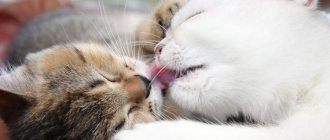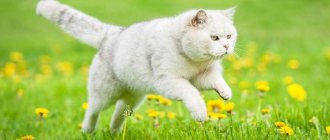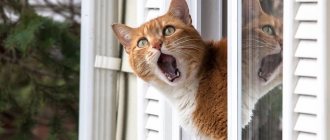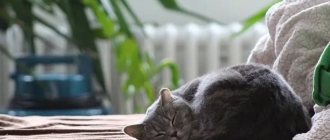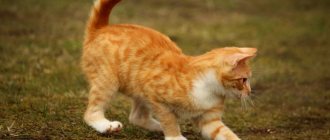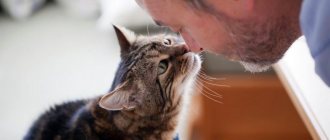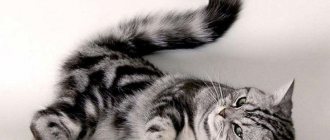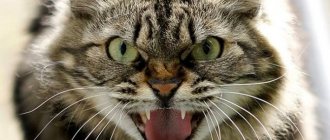Owners of domestic cats know very well that when their pet starts asking for a cat, they can forget about peace in the house. If a cat goes into heat, then she is capable of making very loud and shrill sounds all day long, which interfere with the rest of both all family members and the animal itself. So, your furry pet meows all day long - what to do in this case, how many days does the cat ask the cat and how to calm the pet during this period? All these questions will be answered in this article.
Gulena cat: all the subtleties of the process
There is an opinion that a cat wants a cat in the spring, or more precisely, in March. And it is true... in relation to the “correct” cats living “in nature”. Natural laws tell them to walk in the spring, feed their offspring in the warm season, and in the cold, think only about survival. Unfortunately or fortunately, the sleek, mustachioed pets who live in our homes look down on this opinion. A sweet life and a good diet lead to the fact that they are ready to reproduce throughout the summer and autumn months, and even winter.
At what age does a cat start asking for a cat?
What time do cats start walking? It depends on its breed: usually a cat begins to ask for a cat for the first time in the sixth to tenth month of life. However, despite the onset of puberty before the age of one year, she is not always able to give birth to healthy babies at this time. If a cat wants a cat for the first time, it is advisable not to let them meet at least until the age of one and a half years.
Signs of estrus in a tailed “bride”
What signs in an animal's behavior indicate that a cat wants a cat? There are a lot of them, and it’s difficult not to notice the signs that a cat has gone on a spree:
- the cat screams both day and night, trying to run away from the house;
- cannot stay in one place;
- cuddles up to people and rubs against objects;
- calm cats become aggressive, and vice versa;
- rolls on the floor, lifts its tail up or to the side, tramples with its hind legs, as if squatting on them;
- loses appetite or almost refuses to eat;
- noticeable discharge from the genitals;
- urination becomes more frequent.
How often does a cat ask for a cat?
How many days does a cat walk? The duration of her estrus varies from person to person. But the end of this period, when the cat has gone on a spree, does not mean at all that the owners can relax for a long time: if the “bride” did not manage to meet the “groom”, screaming and rolling on the floor can resume after a week or two. And to the question “how many days does the cat ask for the cat?” the exhausted owners answer: “all 365 in a year!” How this looks in practice, look at the video (Alexey Karasev).
How long does a cat walk?
How long does the cat ask for the cat? The duration of estrus is usually from 7 to 20 days. If the “bride” does not become pregnant, then the “wedding requirements” will be repeated every 14-21 days until she is expecting children or the resting season begins. Occasionally, a third option is also possible, the so-called false pregnancy, which postpones the appearance of a new period when the cat wants a cat.
Stages of heat
The estrus process can be roughly divided into four stages.
- The first is called proestrus. It lasts from 1 to 4 days and is characterized by the relative calm of the animal. The beginning of the period when the cat went on a spree is indicated only by quiet throaty meows and obsessive caressing of the owners. The tailed cat is not yet ready to meet a roaming cat.
- The second period, estrus, can last 7–10 days. The female begins not just to scream, but to scream at the top of her lungs. When you stroke her back, she crouches, moving her tail to the side. This means they are ready to mate. If you want to let her have a kitten or several, it is better to bring a male on the 3rd-5th day of estrus.
- In the third period, metestrus, which lasts from 3 to 12 days, the pet that has walked with the “groom” will drive away all applicants. When fertilization does not occur, a false pregnancy may begin, very similar to the real one, but not ending in childbirth. True pregnancy in your pet lasts 60–70 days.
- In the last, fourth period, called anestrus, she calms down.
How often does heat occur?
Theoretically, by their nature, cats can bear up to six litters per year, and estrus can occur much more frequently.
Cats may look for a mate every three weeks for a week. If mating does not occur, her body will continue to repeat the estrous cycle until pregnancy or sterilization. By the way, after giving birth in many animals, estrus begins after a month and a half.
During heat, cats may try to escape from the house.
The female cycle is directly related to the length of daylight hours. For cats living outdoors, the frequency of estrus increases from late spring to fall, and decreases as daylight hours decrease.
Domestic cats live year-round under artificial light and may experience almost constant hormonal activity.
We help you get through this important period
Estrus is a difficult period both for the tailed pet and for its owners, who are tormented by the question “what to do if the cat asks for a cat?” Some of them, exhausted by exhausting “songs,” begin to rein in the animal in every possible way, scolding it, spanking it, splashing it with water, or even dipping it into an ice bath. And here is the time to remember that we are responsible for those we have tamed. The tamed murka is no exception. It is in such a difficult time, when a cat wants a cat, that she needs attention, affection and patience.
How to manifest them in practice? What to do at home for your pet? Let's give some simple but effective tips:
- talk to your pet in a calm and gentle voice;
- stroke her head, scratch her tummy (but without touching her rump and tail!);
- play with it from time to time to release energy;
- feed small portions and give drinks, especially in hot weather;
- load her with “work” - letting her run after the toy, lick her “fur coat” once again (to do this, you can bathe her in warm water once a day in a room without drafts - also warm!).
But that is not all! Many cat owners confirm the effectiveness of special plant-based calming preparations that do not cause harm, regardless of how often the cats walk. These are the stress-relieving "Cat Bayun", bags or sprays with catnip (spray or sprinkle in the pet's habitat), "Fitex" - a similar effect, calming "Stop-stress" and others.
How to understand that a cat is ready for mating
The owner of the cat will definitely not miss the onset of puberty of the pet. The following signs will eloquently indicate this:
- displays of aggression instead of playfulness;
- annoying meowing and inviting cries;
- unpleasant smell from the cat’s “marks”.
All these signs will begin to appear when the cat reaches the age of 8-10 months. Mating is allowed only when sexual maturity is fully achieved, and this is the age of 1.3-1.5 years. Moreover, it is absolutely not necessary to wait for spring - males, unlike cats, are ready to mate in any season, it’s just that this desire is strongest in spring. Early matings are harmful due to the exhaustion of the animal’s fragile body. Such a cat will quickly become “unsuitable” for reproducing kittens.
Expert advice
What about hormonal drugs? We haven't forgotten about them, of course. However, following the advice of veterinarians, we recommend using them only in exceptional cases. It should be understood that regular use of them causes metabolic disorders in animals. And it already manifests itself in the form:
- inflammation in the organs of the reproductive system;
- problematic pregnancy;
- weak or sick offspring;
- difficult births leading to caesarean sections;
- tumors of the mammary glands and uterus, including malignant ones.
This is why responsible specialists prefer sterilization when owners don’t want to hear about furry children. The advantages of this option for solving the problem of offspring are obvious: you save yourself and your pet from suffering, prevent the dangerous consequences of using hormonal drugs and, in the end, reduce the number of useless defenseless lumps. In addition to the usual hormonal drugs in the form of injections or tablets, there are also chips containing the hormone, which are injected subcutaneously and, if necessary, removed.
However, having decided to sterilize your pet, you should remember that before the operation, they usually need an examination by an experienced veterinarian, and after that - competent and caring care. You also need to find out what she should be vaccinated with. If everything is done professionally and with love, your cat will not be in a state of chaleur, warming the house with its love for many, many years.
Loading …
Sterilization: pros and cons
Owners have different opinions on the issue of sterilization. Some consider this operation to be the only right step towards the pet’s health; for others, it does not seem humane to deprive a cat of the opportunity to give birth to offspring.
It is worth noting that timely sterilization greatly reduces the risk of cancer.
The best time to perform the operation is considered to be the period before the onset of the first estrus or immediately after its end. Also, the possibility of developing breast cancer is reduced to almost zero. It is possible to sterilize at an older age, but then you need to consult a doctor to see if the animal will tolerate anesthesia.
As for deprivation of the right to give birth, such doubts are inherent only to humans. Animals live by instinct and do not dream of a large cat family since childhood.
The veterinary community has come to the conclusion that sterilization is absolutely safe for cats; the only contraindication can be the patient’s advanced age. But the operation once and for all relieves the cat from suffering, minimizes the risk of disease, and also guarantees peace of mind for the owner.
The disadvantages of sterilization include the recovery period. Since the operation is performed under full anesthesia, she needs careful care and attention over the next few days. In addition, changing dressings requires courage from the owner, although it is not difficult.
Kitty in a post-operative bandage
Also, sterilization requires financial investment, and for some owners it seems more convenient to buy medications that stop or reduce the cat’s sexual desire. But you need to understand that often this kind of drug intervention puts the pet’s health at risk.
It is also worth noting that there are often cases when, due to hormonal changes after sterilization, a cat may become less physically active, thus increasing the likelihood of gaining excess weight. But in this case, it is possible to take control of nutrition and independently provoke physical exercise in the cat, which at the same time will add joyful emotions to the animal and its owner.
Photo gallery
Photo 1. Scratching a cat's neck
Photo 2. Close-up of catnip
Photo 3. A rare period of calm during estrus
Features of mating purebred cats
Owners of purebred cats should approach the choice of a partner for mating responsibly - this determines what the offspring will be like. To prevent kittens from inheriting breed defects, you need to choose an ideal mother for them. A “pure” pedigree in a cat will guarantee the absence of physical and genetic abnormalities in the offspring. For successful mating, it is good if both parents have outstanding sires in the family. Specific rules for breeding animals are established by the clubs themselves.
When breeding purebred animals, their blood types must be taken into account so that the kittens do not develop hemolysis, a deadly disease. Therefore, carefully study the compatibility of animals according to this factor. For example, if a cat has group B, then he can be bred with any cat, and if he is A, then mating with a cat with group B is excluded, etc. Don't know your blood type? Then it is worth taking the appropriate test from a veterinarian in advance.
If your cat participates in exhibitions, then take into account their schedule. It is better to breed an animal after an exhibition so that the appearance of the pet does not let us down, since matings directly affect the exterior (coat quality, etc.).
